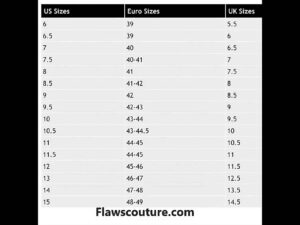When it comes to shoe sizes, different countries follow different sizing conventions, which can sometimes lead to confusion for consumers.
Let’s take a closer look at the European size 41 and its equivalent in the UK.
European Size 41
The European shoe sizing system is widely used across the European continent. In this system, the size is often represented by a number that generally correlates with the length of the foot in centimeters.
Size 41 is one of the common sizes within this system.
Size 41 in the UK
For adult women, the European size 41 typically translates to a UK size 7 or 7.5. For adult men, it usually equates to a UK size 7.
However, it’s essential to remember that there can be slight variations based on the brand and style of the shoe. Always refer to the specific brand’s size chart if available.

Why the Discrepancy?
Shoe sizing can differ for various reasons:
- Measurement Method: Different countries or regions might measure different parts of the foot, leading to variations.
- Last Shape: The “last” is the mold around which a shoe is constructed. Different brands might use different last shapes, which can cause variations in size.
- Material: The materials used in the shoe (leather, synthetic, fabric) can affect sizing, especially regarding how much the shoe might stretch after wear.
- Intended Fit: Some shoes are designed to fit snugly, while others might be designed with a looser fit.
Buying Tips
When converting European sizes to UK sizes or vice versa, consider the following:
- Use Brand Size Charts: If available, always refer to the brand’s size chart. This will give the most accurate conversion for that specific brand.
- Consider Shoe Reviews: Often, buyers leave reviews that might include comments about the shoe’s fit – whether it runs large, true to size, or small.
- Measure Your Foot: If in doubt, measure your foot’s length and width. Many online retailers provide instructions on how to do this accurately.
- When in Doubt, Ask: If purchasing from a physical store, ask to try on multiple sizes to ensure the best fit. For online purchases, consider reaching out to customer service with any sizing questions.
In Conclusion
While European size 41 typically converts to a UK size 7 or 7.5, always ensure you’re getting the correct fit by referring to brand-specific size charts and considering other factors that might influence sizing.
ALSO SEE: Jumia Shoes and Their Prices
FAQs
- What is size 41 in UK women’s shoes?
- Size 41 in European sizing generally translates to a UK size 7 or 7.5 for women.
- What is size 41 in UK men’s shoes?
- For men, European size 41 typically equates to a UK size 7.
- Why is there a difference in men’s and women’s shoe sizes?
- Men’s and women’s shoes are constructed differently, taking into account the general shape and width of feet for each gender.
- Is the shoe size conversion consistent across all brands?
- No, there can be slight variations based on the brand and style of the shoe.
- Where can I find a brand’s shoe size chart?
- Most brands provide a size chart on their official websites or inside their physical stores.
- Why might a shoe fit differently even if it’s my size?
- The material, design, and intended fit can all influence how a shoe feels.
- Is the European shoe size measured in centimeters?
- Generally, the European size correlates with the foot’s length in centimeters, but it’s not an exact measurement.
- If I’m a size 41 in one brand, will I be the same in another?
- Not necessarily. Always refer to the specific brand’s size chart if available.
- How often do shoe sizes change as an adult?
- Adult foot sizes tend to remain stable, but factors like weight gain, pregnancy, or medical conditions can lead to changes.
- How can I measure my foot at home?
- Use a ruler or measuring tape, place your foot on a flat surface, and measure from the heel to the longest toe tip.
- Are there half sizes in European shoe sizing?
- Some brands offer half sizes, but it’s less common than in UK or US sizing.
- What if size 41 feels too tight?
- It’s advisable to go half a size up or refer to another brand’s size chart.
- Can shoe insoles affect size?
- Yes, thick insoles can make a shoe feel tighter.
- Why do some brands not follow standard size conversions?
- Brands might use different last shapes or have unique design elements affecting sizing.
- What’s the difference between size and fit?
- Size refers to the numerical representation, while fit refers to how snug or loose the shoe feels.
- If I wear thick socks, should I go a size up?
- It’s a personal choice, but thicker socks can make shoes feel tighter.
- Are UK shoe sizes the same as US sizes?
- No, UK and US sizes differ. Always check the conversion chart.
- Do feet swell during the day?
- Yes, it’s common for feet to swell slightly, especially after prolonged standing or walking.
- When is the best time to try on shoes for an accurate size?
- Late afternoon or evening, when feet are likely at their largest.
- Can leather shoes stretch out?
- Yes, leather shoes can stretch slightly with wear.
- Is there a width equivalent for size 41?
- Shoe widths vary by brand. Check the brand’s width chart if available.
- How do I know if a shoe is too big?
- If your foot slides easily inside, or if there’s a significant gap at the heel, it might be too big.
- Can shoe inserts help with a size discrepancy?
- Yes, inserts can help make a slightly bigger shoe feel snugger.
- Are children’s shoe sizes the same as adult sizes?
- No, children’s sizes follow a different scale.
- Can I use European size 41 in other countries?
- Yes, the European sizing system is widely used across Europe.
- Why might the same size shoe feel different in two styles from the same brand?
- Differences in design, material, and construction can influence the fit.
- How do sandals and boots compare in size to regular shoes?
- Sandals might fit differently due to open design, and boots might feel tighter around the ankle.
- Should I choose shoe size based on length or width?
- Both factors are essential, but it’s crucial to ensure that the shoe doesn’t pinch or feel too tight lengthwise.
- Can I exchange shoes if the size isn’t right?
- Most retailers offer exchanges, but always check the return policy.
- Why do some shoes only come in whole sizes?
- Some designs or brands opt for whole sizes to simplify inventory.
- How can I prevent blisters when wearing a new size 41 shoe?
- Ensure the shoe fits well and consider using blister pads or wearing thicker socks.
- Do high heels and flats fit the same in size 41?
- They might differ due to design. Always try before buying.
- Is it okay for my toes to touch the shoe’s end?
- There should be a slight gap to prevent discomfort.
- Do running shoes fit differently than casual shoes in size 41?
- Yes, some people opt for a slightly larger size in running shoes for comfort.
- How can I ensure online shoe purchases fit correctly?
- Check the brand’s size chart and read customer reviews.
- Can shoe size affect foot health?
- Yes, wearing the wrong size can lead to various foot issues.
- Is size 41 common?
- Yes, size 41 is a relatively common shoe size.
- Can shoe stretching tools adjust size 41 shoes?
- They can make minor adjustments, especially in width.
- How can I know if a shoe will stretch with wear?
- Leather shoes are more likely to stretch than synthetic ones.
- Why might two pairs of size 41 shoes from the same brand fit differently?
- Variations in manufacturing, design, or quality control can lead to slight differences.
Remember, the most important factor is comfort. Always prioritize how the shoe feels on your foot over the numerical size.

Leave a Reply